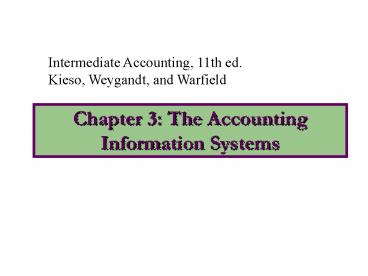Chapter 3: The Accounting Information Systems PowerPoint PPT Presentation
1 / 12
Title: Chapter 3: The Accounting Information Systems
1
Chapter 3 The Accounting Information Systems
Intermediate Accounting, 11th ed. Kieso,
Weygandt, and Warfield
2
The Basic Accounting Equation
- Accounting data is represented by the following
relationship among the assets, liabilities and
owners equity of a business - Assets Liabilities Owners Equity
- The equation must be in balance after every
recorded transaction in the system.
3
The Double Entry System
- Accounting information is based on the double
entry system. - An account is an arrangement of transactions
affecting a given asset, liability or other
element. - Under this system, the two-sided effect of a
transaction is recorded in the appropriate
accounts. - The recording is done by means of a
debit-credit convention (set of rules) applying
to all accounts.
4
The Account and the Debit-Credit Convention
5
Expanded Basic Equation and Debit/Credit Rules
and Effects
6
Ownership (Equity) Structure
Owners Equity
7
The Accounting Cycle Steps
- 1. Analyze the transaction
- 2. Journalize the transaction
- 3. Post the transaction to accounts in ledger
- 4. Prepare the (unadjusted) trial balance
- 5. Prepare necessary adjusting journal entries
- 6. Prepare the adjusted trial balance
- 7. Prepare financial statements
- 8. Prepare closing journal entries for the year
- 9. Prepare the post-closing trial balance
8
Adjusting Journal Entries
- Adjusting entries are needed for
- Recognizing revenue for the period.
- Matching expenses with revenues they helped
generate. - Adjusting entries are required every time
financial statements are prepared.
9
Closing Journal Entries
- Closing entries are made to close all nominal
accounts (revenue and expense accounts) for the
year. - Real (or Permanent) accounts (balance sheet
accounts) are not closed. - Dividend account is closed to Retained Earnings
account.
10
Closing Entries Periodic Inventory System
- In a periodic inventory system, closing entries
are made to record cost of goods sold and ending
inventory. - In a perpetual inventory system, such entries are
not required.
11
Using a Worksheet
- A worksheet is a multiple column form that may be
used in the adjustment process and in preparing
financial statements. - The use of a worksheet is optional and not a
permanent accounting record. - The worksheet does not replace the financial
statements.
12
Steps in Preparing a Worksheet
- Prepare a trial balance on the worksheet.
- Enter the adjustments in the adjustments column.
- Enter adjusted balances in the adjusted trial
balance columns. - Extend adjusted trial balance amounts to
appropriate financial statement columns. - Total the statement columns, compute net income
(loss), and complete the worksheet.

